Hall

Vous voulez nous aider à la compléter ?
Pensez à vérifier que cette page est à jour avec son contenu d'Inkipedia EN !

- Pour les musiques, voir Inkopolis Lobby.

Le hall est l'écran de séléction des modes dans la série Splatoon où les joueurs peuvent choisir un type de mode de jeu, ainsi qu'une zone où le joueur peut se balader dans Splatoon 3. Dans Splatoon, le joueur peut entrer dans la Tour de Chromapolis depuis la Place de Chromapolis ou en appuyant sur "Hall" sur la carte du ![]() pour accéder au hall. Dans Splatoon 2, le joueur peut entrer dans la Céphalotour depuis le square de Chromapolis ou sélectionner "Hall" après avoir appuyé sur . Dans Splatoon 3, le joueur peut entrer dans le Hall depuis la Cité-Clabousse ou en sélectionnant "Hall" après avoir appuyé sur . Dans Splatoon 3: Pass d'extension, le joueur peut soit entrer dans la Tour de Chromapolis à Chromapolis, soit entrer dans la Céphalotour au square de Chromapolis, ou en sélectionnant "Hall" après avoir appuyé sur .
pour accéder au hall. Dans Splatoon 2, le joueur peut entrer dans la Céphalotour depuis le square de Chromapolis ou sélectionner "Hall" après avoir appuyé sur . Dans Splatoon 3, le joueur peut entrer dans le Hall depuis la Cité-Clabousse ou en sélectionnant "Hall" après avoir appuyé sur . Dans Splatoon 3: Pass d'extension, le joueur peut soit entrer dans la Tour de Chromapolis à Chromapolis, soit entrer dans la Céphalotour au square de Chromapolis, ou en sélectionnant "Hall" après avoir appuyé sur .
Splatoon
Pour rejoindre une partie en ligne dans Splatoon, le joueur doit se rendre à la Tour de Chromapolis.
Options
En entrant dans la Tour, le joueur est présenté avec 5 options de connexions différents à choisir. Ces options sont Match en groupe, Match pro, Match classique, Match classique avec tes amis !, et Match privé. Choisir parmi ces options permettra au joueur de rejoindre des matchs en ligne ou de créer une partie. La sixième option est le Mode balade, bien que cela ne connectera pas le joueur dans des matchs en ligne.
Match en groupe

Les matchs en groupes permettent aux joueurs de rejoindre des matchs pro. Cependant, contrairement à l'option Match pro, il permet à n'importe quel groupe de deux à quatre joueurs de former une équipe pour affronter des autres équipes dans des matchs pro. Si une équipe n'est formée que de deux joueurs, elle sera couplée avec une autre équipe de deux joueurs pour former une équipe de quatre, contre quatre autres joueurs. Si une équipe est composée de seulement trois joueurs, elle pourra rencontrer une partie en 3v3 ou en 3v4. Les équipes de quatre peuvent affronter une équipe de trois ou quatre joueurs. Les rangs des joueurs montent et descendent à mesure de leurs victoires et défaites jusqu'à atteindre l'un des rangs S. Les matchs sont joués sur les deux stages et avec le mode de jeu actuellement dans la rotation des matchs pro. Contrairement aux modes en ligne, les joueurs peuvent changer leurs armes et leurs équipements avant les matchs et peuvent quitter la session à n'importe quel moment.
Ce mode a été succédé par Match de ligue dans Splatoon 2.
Match pro

Cette option permet aux joueurs de rejoindre les matchs pro avec des joueurs du monde entier comme une version aléatoire des matchs en groupe. Ce mode a un système de rang qui regroupe des joueurs du même niveau dans un match. Ce modeest plus compétitif vu que les équipes gagnent bien plus de points de match et de l'argent en gagnant un match. Les rangs des joueurs sont négativement affectés par une défaite, faisant des victoires une grande priorité dans ces matchs. Au vu de sa compétitivité, les joueurs ne peuvent pas rejoindre leurs amis dans ce mode. il y a troise modes de jeu disponibles dans les matchs pro : Défense de zone, Expédition risquée et Mission Bazookarpe.
Ce mode revient dans Splatoon 2 et Splatoon 3, similaire à comment il fonctionnait dans le premier jeu. De plus, un mode de jeu supplémentaire a été ajouté sous le nom de Pluie de palourdes. Dans Splatoon 3, ce mode a été succédé par Match anarchie.
Match classique

Cette option permet au joueur de rejoindre des parties en ligne non classés avec des joueurs du monde entier. Ces matchs sont plus amicaux et les équipes victorieuses ou perdantes reçoivent toutes deux des récompenses à la fin de chaque match. Le seul mode dans Match classique est la Guerre de territoire, le mode principal de Splatoon.
Ce mode revient dans Splatoon 2, similaire à comment il fonctionnait dans le premier jeu.
Avec tes amis !
Cette option permet aux joueurs de rejoindre des guerres de territoire ou des matchs pro (bien que ce cela peut être utilisé pour rejoindre des matchs en groupe/de ligue). Cependant, plutôt que de rejoindre une partie avec des joueurs aléatoires du monde entier il permet à la place aux joueurs de rejoindre n'importe quel ami qui est actuellement en train de jouer dans un match classique. Si le joueur est rejoignable, en sélectionnant son pseudo, le joueur devra attendre dans un écran de chargement jusqu'à ce que le match de cet ami se termine avant qu'il puisse le rejoindre. Après que l'écran des résultat s'achèvent, et si l'un des huit emplacements de la session de cet ami se libère, le joueur pourra ensuite le rejoindre. Il est à noter que cette option ne garantit pas que les deux amis seront placés dans la même équipe lors des matchs.
Ce mode revient dans Splatoon 2 et Splatoon 3, similaire à comment il fonctionnant dans le premier jeu.
Match privé
Les matchs privés permettent aux joueurs de créer une session personnalisée que des amis peuvent rejoindre. L'hôte de la session peut changer différents paramètres du match, comprenant quels modes et stages seront joués. L'hôte peut aussi décider dans quelle équipe seront placés les joueurs. Les associations d'équipe peuvent varier de n'importe quelle combinaison de un à quatre joueurs. Les rangs des joueurs et leur niveau ne seront pas affectés dans ces matchs. Cependant, comme les matchs en groupe/de ligue, les joueurs peuvent changer leurs armes et leurs équipements avant le match, et n'importe quel joueur peut se déconnecter de la session lorsqu'ils le souhaitent.
Ce mode revient dans Splatoon 2 et Splatoon 3. En plus des huit joueurs, il peut maintenant y avoir deux gradins supplémentaires dans la session. L'hôte peut aussi choisir un mot de passe pour la session.
Balade
Le mode balade, accessible en appuyant sur ![]() dans le hall permet aux joueurs d'explorer librement n'importe quel stage actuellement disponible dans la rotation pour les matchs classique, les matchs pro et les matchs de ligue avant de rejoindre une session en ligne. Ce mode est utile pour trouver les positions privilégiées d'un stage ou de s'habituer à un nouveau stage dans une rotation. Si le joueur part en balade sur n'importe quel stage dans la rotation des matchs pro, le stand mobile, les zones clés et le Bazookarpe seront aussi positionnés sur le stage (avec les changements apportés aux stages selon le mode qui vont avec), selon le mode actuel de la rotation.
dans le hall permet aux joueurs d'explorer librement n'importe quel stage actuellement disponible dans la rotation pour les matchs classique, les matchs pro et les matchs de ligue avant de rejoindre une session en ligne. Ce mode est utile pour trouver les positions privilégiées d'un stage ou de s'habituer à un nouveau stage dans une rotation. Si le joueur part en balade sur n'importe quel stage dans la rotation des matchs pro, le stand mobile, les zones clés et le Bazookarpe seront aussi positionnés sur le stage (avec les changements apportés aux stages selon le mode qui vont avec), selon le mode actuel de la rotation.
Ce mode revient dans Splatoon 2, similaire à comment il fonctionnait dans le premier jeu. Avec l'ajout de Pluie de palourdes, les palourdes et le panier apparaîtront sur le stage de même.
Splatoon 2
Pour rejoindre une session dans Splatoon 2, le joueur doit entrer dans la Céphalotour.
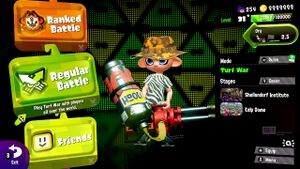
Options
En entrant dans la Céphalotour, le joueur est présenté devant 6 options de connexion différentes à choisir. Ces options sont Match de ligue, Match pro, Match classique, Amis, Match privé et Online Lounge. Selecting any of these options allows players to join online or create lobbies. A seventh option, Recon, is also available, although it does not connect players to online lobbies.
Match de ligue
Le Match de ligue permet aux joueurs de rejoindre des matchs pro. En tant que remplaçant de Match en groupe, il fonctionne de la même manière; plutôt qu'avoir huit joueurs aléatoires du monde en tier qui rejoignent la partie, cette option permet à un groupe de deux ou quatre joueurs de former une escouade pour combattre dans des matchs pro contre une autre escouade. Si une équipe n'est formée que de deux joueurs, elle sera couplée avec une autre équipe de deux joueurs pour former une équipe de quatre, contre quatre autres joueurs. Les équipes de quatre peuvent affronter une équipe de trois ou quatre joueurs. Les rangs des joueurs ne sont pas affectés. Les matchs sont joués sur l'un des deux stages et le mode de la rotation. Contrairement aux autres options, les joueurs peuvent quitter la session à tout moment.
Online Lounge
L'Online Lounge permettait aux joueurs d'utiliser l'application Nintendo Switch Online de chatter en vocal tout en jouant au jeu. Cette option a pris fin le 28 juillet 2021, le rendant injouable.
Splatoon 3
Tour du hall
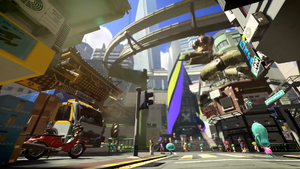
La tour du hall est la tour central de la Cité-Clabousse dans Splatoon 3. Elle n'a pas de nom officiel.
Apparence
La tour a un design moderne et arrondi. Trois grands écrans sont enroulés tout autour de la tour. Les écrans diffusent les couleurs d'encre, de gauche à droite, de Raimi, Angie et Pasquale. Les murs qui ne sont pas couverts d'écrans sont en glace, avec des motifs à l'intérieur. Au total, il y a quatre marches qui mènent au hall, trois qui mènent à une plateforme et une menant à l'entrée. L'entrée est une porte automatique transparente, qui s'ouvre lorsque le joueur escalade les trois marches qui mènent à la plateforme. L'intérieur est décoré de vitres réfléchissantes, avec le centre menant au hall. La porte du hall a un logo de Guerre de territoire blanc dessus.
Other lobby towers
Inkopolis Tower and Deca Tower return in Inkopolis Plaza and Inkopolis Square respectively, and are used to access the lobby from those hubs. Their lobbies are identical to that of Splatsville's, though the song rotation is slightly different.
Options
Once the player enters the tower, the player will be able to access the online competitive modes: Join Friends, Tableturf Battle, Private Battle, Challenge, Turf War, and Anarchy Battle, a version of Ranked Battle. Selecting any of these options allows players to join online or create lobbies. Recon is located outside of the lobby and hosted by Staff; it does not connect players to online lobbies.
Tableturf Battle
This option allows players to join lobbies or create lobbies for player-versus-player Tableturf Battle. After a game, points are added to the player's Tableturf Rank based on how many spaces they inked.
Challenge
Challenge is a temporary game mode, similar to how Salmon Run is scheduled in Splatoon 2, that replaces Splatoon 2's League Battle. Challenges are competitions with unique conditions for the players. Challenges take place on different modes, with some taking place in Anarchy Battle game modes and others on Turf War. Winning five challenges awards the player with Shell-Out Machine Tokens for free rolls.
Anarchy Battle
Anarchy Battle is the successor to Splatoon and Splatoon 2's Ranked Battle. The mode uses a ranking system that groups players of the same level together for battles. Players earn more for winning than they do losing, and losses given more severe penalties than in other modes.
In Splatoon 3, Anarchy Battle has two versions, Open and Series. Series Battle is similar to Ranked Battle, and can only be played solo. Players pay rank points to enter a series of games; if they can win five before losing three, they will earn a large sum of points that count towards their Anarchy rank. If the player loses before then, they are given a smaller sum of points that typically results in a net loss.
Open Battle is a less competitive version of Series Battle. Players are still ranked, but play one game instead, and are given points depending on whether they won. Unlike Series, Open Battle can be joined by friends.
The game modes in Anarchy Battle are the same in Splatoon 2: Splat Zones, Tower Control, Rainmaker, and Clam Blitz.
X Battle
X Battle is the successor to Splatoon 2's X Rank. Similar to Anarchy Battle (Series), the player is entered into a series in which the player must win a certain number of games. Additionally, it uses X Power, similar to Splatoon 2. However, instead of being a separate rank, the player only has to be in S+0 or higher to unlock X Battles.
The player must complete five placement matches to determine their initial X Power, halving the amount from Splatoon 2. Unlike Anarchy Series, the player only needs to win three matches instead of five. The player either gains or loses points of their X Power depending on the outcome of the series.
X Battles are separated into two divisions, each sponsored by a gear brand:
 Cubic Division covers players from Japan, Hong Kong, South Korea, Australia and New Zealand
Cubic Division covers players from Japan, Hong Kong, South Korea, Australia and New Zealand OculR Division covers players from North America, South America, and Europe
OculR Division covers players from North America, South America, and Europe
Players choose their division the first time they play X Battles in a given season, and are unable to change the division until the next season.
Lobby mechanics
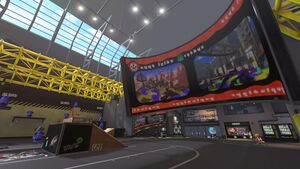
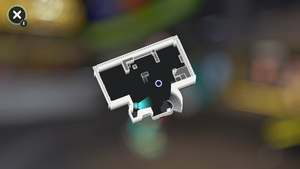
| “ | Welcome to the lobby! It's your portal to online battles... and where you stash all your gear. As you splat forth in online battles, you'll level up and earn cash, to boot. Why level up and get cash? So you can access and afford the freshest gear in Splatsville! And some battle modes are restricted to players at a higher level too. So get that level up! | ” |
— In-game description
| ||
Unique to Splatoon 3, the lobby is now a physical area inside the towers that the player can walk around in. The lobby houses a test range where players can practice while queuing for a match, the locker room, and the Crab-N-Go, where players can purchase food and drinks. Anyone on the player's friends list can be found inside near the exit, where each friend is represented as a ghost. Players can interact with these ghosts and use them to join their friends in an online battle. Anyone queued for battle alongside the player will also be represented as a ghost to said player, with their actions in the test range being displayed in real-time. Additionally, as of version 3.0.0, the player can join Pools that allow them to coordinate with specific groups from the lobby menu.
At the back right of the test range area, there is the Copy Machine. On the inkable wall to the left of the machine is a drawing of the lobby layout.
The lobby has an upstairs café area accessible by walking up the staircase next to the terminal. Once a player steps on the staircase, their weapons and specials are removed until they re-enter the ground floor of the lobby. Additionally, the player's user interface is changed, displaying their level, cash, Anarchy Battle rank, amount of Super Sea Snails, and any experience or cash boosts they may have active. A jellyfish referred to simply as Cool Jelly in Tableturf Battle is seen attending the café counter, stocked with miscellaneous café items such as coffee machines, mugs, and bean bags. On the same floor, there are five arcade-like machines used for accessing online Tableturf Battles. A studio is visible in this area operated by two jellyfish, one being the Aggro Jelly seen in Tableturf Battle.
Beneath the café is the locker room. To get to the locker room, the player must be level 4 or higher and simply walk up to the sliding doors, which will open just as the player gets to them. The sliding doors remain blacked out at a distance and before the player hits level 4. Once inside, the player can view their own locker, edit it if they so desire, and view the lockers of players they have recently played with, as well as a random selection of highly 'Fresh' rated lockers.
As of version 3.0.0, there is a jukebox near the Crab-N-Go, replacing one of the vending machines. Players can use it to change the background music in the lobby to a song of their choice. More songs can be selected as the player progresses through the game's single-player modes. Selecting a new song in a Private Battle room also sets it to play in the lobbies of other players in that room.
Music
The music that plays in the lobby by default follows a consistent weekly schedule outside of Splatfests, changing music every hour at the top of the hour.
Certain hours will play different music depending on the hub location that the lobby is entered from.
| Weekday & weekend selections | ||||
|---|---|---|---|---|
| Lobby | Weekdays | Weekends | ||
| Splatsville |  |
Sinkopated Backwash |
 |
Drip Feed Turf Love |
| Inkopolis Plaza |  |
Inkopolis Lobby |
 |
Inkopolis News Squid Sisters |
| Inkopolis Square |  |
Without a Dop Doubt |
 |
Inkopolis News Off the Hook |
At 2AM, 10AM, and 6PM UTC, the lobby will play one of six playlists of select battle themes from previous Splatoon games, rotating through songs in a set order every five minutes until the hour is up. The legacy playlist will be played for all three of the designated hours in a particular day, then rotate to the next playlist in sequence for the next day. For instance, if Wet Floor's playlist occurs on a Wednesday, then Thursday will feature the Bottom Feeders playlist, and the next occurrence of the Wet Floor playlist will be the following Tuesday.
If the lobby is loaded within the first minute of the legacy hour, or if the player is in a menu when the hour rolls over, a version of Opening will play corresponding to the game that the playlist's leading song originates from. Since these songs are not available from the jukebox normally, this will display the cover and title of the previous song to play in the jukebox for the duration if the jukebox is open while the transition occurs, or the cover and title of the playlist's leading song if the lobby is entered during the first minute of the legacy hour.
Playlists are presented in the order of their daily rotation.
Hourly music rollovers occur independently of reloads triggered by map rotation updates; if the player prevents the bi-hourly reload from occurring immediately by remaining in a menu, the lobby music will still update.
Lobbies
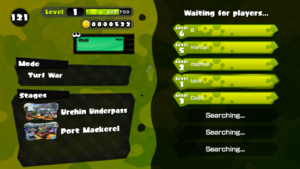
Lobbies are the areas where players wait for battles to begin. Once a player joins a lobby after selecting any of the options listed above, they cannot leave or change their weapon or gear, unless it is a Private Battle.
Before a battle
When the player selects one of the connection options, Nintendo's matchmaking service finds a lobby for the player to join. If there is no joinable lobby for the option the player selected, they are placed in a waiting screen with a timer that shows when the first joinable lobby will become available. Upon joining a lobby, the player must sit on a lobby screen until the battle begins. This screen displays eight slots on the right of the screen, each of which fills up as players join the lobby. The screen also displays several other things, including:
- The names of the players currently in the lobby, their Levels, and their rank, if in a Ranked Battle.
- The current mode and stages.
- The player's vibe meter or Splatfest Power during a Splatfest as well as their amount of cash.
- A countdown in the upper-left corner of the screen. If this countdown reaches zero before eight players have joined the lobby, everyone in the lobby is disconnected.
While waiting for the battle to start, as well as while waiting to join a lobby, the player can play a minigame on the ![]() by pressing
by pressing ![]() . Squid Jump is the only minigame available from the start, but more minigames can be unlocked by playing through amiibo challenges. Once eight players have joined the lobby, the screen will display "BATTLE TIME!" in the North American version of the game, and "Let Battle Commence!" in the European version. Then the minigame will pause and the battle will start.
. Squid Jump is the only minigame available from the start, but more minigames can be unlocked by playing through amiibo challenges. Once eight players have joined the lobby, the screen will display "BATTLE TIME!" in the North American version of the game, and "Let Battle Commence!" in the European version. Then the minigame will pause and the battle will start.
After a battle
After the battle has finished and Judd has determined which team has won, each player is taken to a results screen, which shows how many splats and deaths each player had and how many Battle Points each player earned. After this, the player's Rank (Ranked Battle only) and level may change depending on performance, and the player is given the option to either play another round in the same lobby or disconnect from the lobby. If the player chooses to disconnect, they are taken back to the lobby.
Matchmaking
Matchmaking mode choices are available from the lobby menu. The matchmaking mode determines which stages a player can play on, which game modes can be played, and how opponents are chosen.
In Ranked Battles, players play against players with the same letter grade as the players are split between different skill brackets.
Each matchmaking mode in Splatoon 2 has a specific "index number" assigned to it. These indices differ between regions. Each number represents a specific matchmaking configuration. While everyone is put into the same matchmaking pool (per matchmaking mode), the matchmaking server will attempt to match a player using the configuration for their region and matchmaking mode. To determine which session someone should be matched with, each criterion in the configuration is assigned a score value, and the session with the highest total score is chosen.
Here is the list of criteria that Nintendo can assign scores to, among others:
- The difference in power level between the session owner and the joining player
- The difference in the rate of disconnection between the owner and joining player
- How far the distance between the owner and the joining player is
- If the country of origin matches
- How long the session has been waiting for players[1]
Team breakdown
In Ranked Battles, before Splatoon 2 version 4.3.1, the number of players using weapons from different classes, such as shooters or rollers, had a significant impact on team breakdown. From version 4.3.1 onward, the specifications for each specific weapon are given more weight when splitting up teams. Each weapon got a rating value named matchmaking range that is relative to its firing range. The matchmaking server forms teams with a similar average of the weapons' matchmaking range.
Communications error
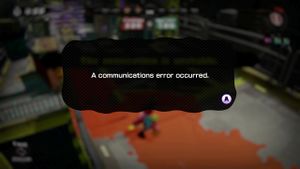
If a player's internet connection is not good enough to stay in the lobby or battle, they are disconnected from the lobby. This is also called a communications error. If this occurs before the battle starts, the player simply receives a message that states that "A communications error occurred" and they are disconnected from the lobby. If this happens during or directly after a battle before the results screen, a message comes up saying the same thing, and the player will again be disconnected. On the results screen, it shows that the disconnected player had zero splats and deaths, and in Regular Battles, it shows that they inked zero points of turf (unless their team won, in which case it shows that they earned 1000p). In both instances, the disconnected player returns to the lobby. If a player disconnects too often, they will not be able to play online for a while.
Splatfest

During Splatfest, the lobbies are a bit different than normal. Upon first entering the lobby, the player is not given the five normal connection options. Rather, the only options in the lobby are to create a Private Battle or to join a Splatfest Battle. Upon joining a Splatfest lobby, one can notice other differences in the online lobbies as well. Rather than having eight player slots on the right of the screen all in a row, the eight slots are divided into two groups of four. These two groups represent the players that will be battling for both Splatfest teams. Once all the players of one team have joined, the screen says that that team is ready. Once the other team joins, the game says that they are ready, and then the battle starts.
Counters and meters
Several different counters and meters are displayed in the lobby, each serving a different purpose.
Level

- Article principal: Level
The level meter indicates how "fresh" a player is. This is a general indicator of that player's playtime but is necessary for things like being granted access to shops or Ranked Battle.
Vibe
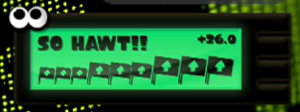
- Article principal: Vibe
The vibe meter shows how well a player is doing in the current game session. It is measured using flags, with every victory scoring one extra flag, but every loss decreasing the number of flags by a variable amount. A player's vibe determines the amount of cash they get from Judd when they talk to him.
Splatfest Power

- Article principal: Power level
Rank

- Article principal: Rank
The rank meter shows what rank the player is at and how close or far they are to going up or down a rank. Ideally, players in Ranked Battle get paired up with players with similar ranks.
Splatfest rank

- Article principal: Splatfest#Reward Tiers
During Splatfest, players had a meter that started them off at the lowest classification, and as they battled more, it went up. A player's classification determined how many Super Sea Snails they got at the end of the event.
Cash

- Article principal: Cash
The cash counter shows how much cash the player currently has.
Super Sea Snails

- Article principal: Super Sea Snail
The Super Sea Snail counter shows how many Super Sea Snails the player currently has. It only appears once the player collects their first Super Sea Snail. Using up all the snails does not remove the counter.
Quotes
| “ | With that out of the way, let's talk a bit more about how the lobby works in Splatoon 3. At the center of all multiplayer battles, the lobby is equipped with state-of-the-art facilities to help Inklings and Octolings get matched up in Turf War battles and more. | ” |
— @SplatoonNA on Twitter[2]
| ||
| “ | Splatlands' main tower is home to the all-new lobby. Here, you can customise your locker, warm up on the test range, view recent results and replays, and team up with friends by talking to their ghost! | ” |
— @NintendoEurope on Twitter[3]
| ||
| “ | Welcome to the lobby! It's your portal to online battles...and where you stash all your gear. As you splat forth in online battles, you'll level up and earn cash, to boot. Why level up and get cash? So you can access and afford the freshest gear in Splatsville! And some battle modes are restricted to players at a higher level too. So get that level up! First things first. Why don't you check out the battle pot over there and select Regular Battle. That'll get you into a Turf War battle. Your team will have three minutes to ink the most turf! Eh, less chat, more splat. Let's get started! | ” |
— When a player enters Splatoon 3's lobby for the first time.
| ||
Audio
- Article principal: Music
Splatoon
| Fictional band | Song name | Audio |
|---|---|---|
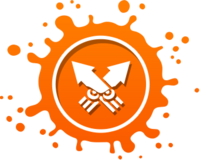 |
Lobby | |
 |
Dubble Bath |
Splatoon 2
| Fictional band | Song name | Audio |
|---|---|---|
 |
Without a Dop Doubt | |
 |
Dubble Bath (DIY Remix) |
Splatoon 3
In Splatoon 3, a variety of music can play in the Splatsville lobby, including a number of new lobby music, and multiplayer battle songs from the previous games. The lobby music changes every hour. The Inkopolis Plaza lobby plays Inkopolis Lobby and the Squid Sisters version of Inkopolis News, replacing Sinkopated and Drip Feed respectively in the rotation of lobby music. In the Inkopolis Square lobby, Without a Dop Doubt and the Off the Hook version of Inkopolis News are heard in place of these songs. Normally during Splatfests, only Soak & Stomp will play in all three lobbies, with the exceptions of Splatoween, when Deepers Creepers was played; FrostyFest, when Yule Tide was played; and SpringFest, when Meadowlark was played. Starting from version 3.0.0, the player can also change the music in the lobby by using the jukebox. A separate jingle plays dynamically near the Crab-N-Go window, which also changed for special Splatfests. After a Splatfest ends, starting with version 5.0.0, the background for a lobby changes for 24 hours to match the music played in the hub: Daybreaker Anthem in Splatsville, Maritime Memory in Inkopolis Plaza, and Into the Light in Inkopolis Square.
- New lobby music in Splatoon 3
| Fictional band | Song name | Audio |
|---|---|---|
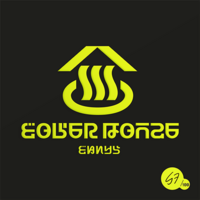 |
Sinkopated | |
 |
Drip Feed | |
 |
Heliocentri City | |
 |
Fuzzy Dazzler | |
 |
Blop Bop | |
 |
Gilded Cage | |
 |
Dressed to Krill | |
 |
Slick Moves | |
 |
Belly Flop | |
 |
Gillty | |
 |
Pour It On | |
 |
Pop 'n' Schlock | |
 |
Clashing Colors | |
 |
Dorsal Slicer | |
 |
Soak & Stomp (First Half) | |
| Soak & Stomp (Second Half) | ||
 |
Deepers Creepers (First Half) | |
| Deepers Creepers (Second Half) | ||
 |
Yule Tide | |
 |
Meadowlark |
Gallery
-
Alternate icon with outline.
-
Lobby menu (pre-version 2.0.0.
-
Lobby menu during a Splatfest (pre-version 2.6.0.
-
A Private Battle lobby.
-
Loading screen in the lobby.
-
-
Splatoon 2 menu icon.
-
Splatoon 3 menu icon.
-
Splatoon 3's lobby menu.
-
A player inside the battle pot.
-
Splatsville's tower during a Splatfest.
Trivia
- In Splatoon, while in the lobby, if the player presses
 and opens the Friends List, a communications error occurs when the player returns to the game, being sent back to Inkopolis Plaza and having to connect to the internet once again.
and opens the Friends List, a communications error occurs when the player returns to the game, being sent back to Inkopolis Plaza and having to connect to the internet once again.
- In Splatoon 2, this occurs if the player stays on the Home Screen of the Nintendo Switch for 30 seconds or more.
- On Splatoon 2's lobby screen, the player can make their own remix of Dubble Bath (DIY Remix) while waiting for the remaining players to join. Pressing any button will play a unique recording or special effect or change the song in some way. The and will adjust the volume and distort the sound respectively. , , and will add different "echoing" voice effects. , , , and play different voice recordings. This feature is unavailable in Private Battle lobbies.
- In Splatoon 3, the lobby has a chance of playing previous multiplayer songs from Splatoon and Splatoon 2.
- The battle pot's design seems to be based on an electric water boiler.
Names in other languages
| Langue | Nom | Signification |
|---|---|---|
| ロビー robī |
Lobby | |
| Lobby | Lobby | |
| Vestíbulo | Lobby | |
| Lobby | Lobby | |
| Lobby | Lobby | |
| Холл Kholl |
Hall | |
| 大厅 dàtīng |
Lobby | |
| 大廳 dàtīng (Mandarin) daai6 teng1 (Cantonese) |
Lobby | |
| 로비 lobi |
Lobby |
| Langue | Nom | Signification |
|---|---|---|
| バトルポット batorupotto |
Battle pot | |
| Kampfkocher | Battle Pot | |
| Hervidor de combate | Battle kettle | |
| Bollibattaglie | Battle boiler | |
| Knokpot | Fight pot[a] | |
| Бой-котел Boy-kotyol |
Fight pot | |
| 对战壶 duìzhàn hú |
Battle pot | |
| 對戰壺 duìzhàn hú (Mandarin) deoi3 zin3 wu2 (Cantonese) |
Battle pot | |
| 배틀 포트 baeteul poteu |
Battle pot | |
| Lobby_Obj_01[4] |
Translation notes
- ↑ From knokken ("to fight, to beat up") and pot
References
|


















